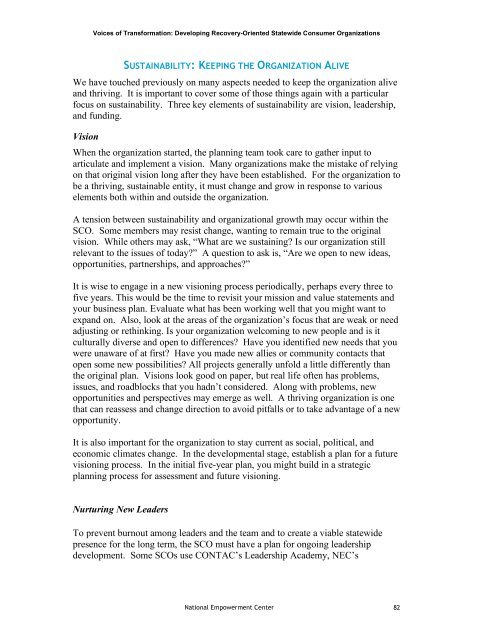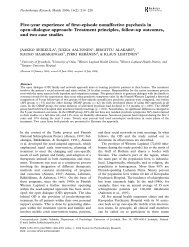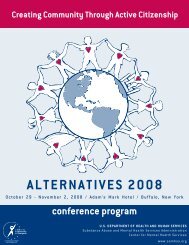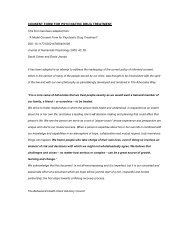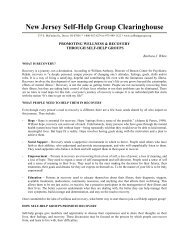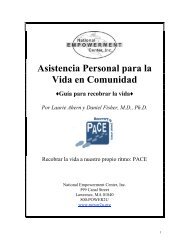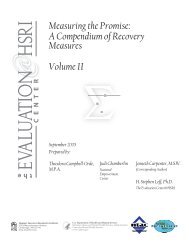Voices of Transformation - National Empowerment Center
Voices of Transformation - National Empowerment Center
Voices of Transformation - National Empowerment Center
Create successful ePaper yourself
Turn your PDF publications into a flip-book with our unique Google optimized e-Paper software.
<strong>Voices</strong> <strong>of</strong> <strong>Transformation</strong>: Developing Recovery-Oriented Statewide Consumer Organizations<br />
SUSTAINABILITY: KEEPING THE ORGANIZATION ALIVE<br />
We have touched previously on many aspects needed to keep the organization alive<br />
and thriving. It is important to cover some <strong>of</strong> those things again with a particular<br />
focus on sustainability. Three key elements <strong>of</strong> sustainability are vision, leadership,<br />
and funding.<br />
Vision<br />
When the organization started, the planning team took care to gather input to<br />
articulate and implement a vision. Many organizations make the mistake <strong>of</strong> relying<br />
on that original vision long after they have been established. For the organization to<br />
be a thriving, sustainable entity, it must change and grow in response to various<br />
elements both within and outside the organization.<br />
A tension between sustainability and organizational growth may occur within the<br />
SCO. Some members may resist change, wanting to remain true to the original<br />
vision. While others may ask, “What are we sustaining? Is our organization still<br />
relevant to the issues <strong>of</strong> today?” A question to ask is, “Are we open to new ideas,<br />
opportunities, partnerships, and approaches?”<br />
It is wise to engage in a new visioning process periodically, perhaps every three to<br />
five years. This would be the time to revisit your mission and value statements and<br />
your business plan. Evaluate what has been working well that you might want to<br />
expand on. Also, look at the areas <strong>of</strong> the organization’s focus that are weak or need<br />
adjusting or rethinking. Is your organization welcoming to new people and is it<br />
culturally diverse and open to differences? Have you identified new needs that you<br />
were unaware <strong>of</strong> at first? Have you made new allies or community contacts that<br />
open some new possibilities? All projects generally unfold a little differently than<br />
the original plan. Visions look good on paper, but real life <strong>of</strong>ten has problems,<br />
issues, and roadblocks that you hadn’t considered. Along with problems, new<br />
opportunities and perspectives may emerge as well. A thriving organization is one<br />
that can reassess and change direction to avoid pitfalls or to take advantage <strong>of</strong> a new<br />
opportunity.<br />
It is also important for the organization to stay current as social, political, and<br />
economic climates change. In the developmental stage, establish a plan for a future<br />
visioning process. In the initial five-year plan, you might build in a strategic<br />
planning process for assessment and future visioning.<br />
Nurturing New Leaders<br />
To prevent burnout among leaders and the team and to create a viable statewide<br />
presence for the long term, the SCO must have a plan for ongoing leadership<br />
development. Some SCOs use CONTAC’s Leadership Academy, NEC’s<br />
<strong>National</strong> <strong>Empowerment</strong> <strong>Center</strong> 82


